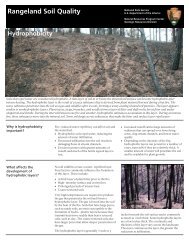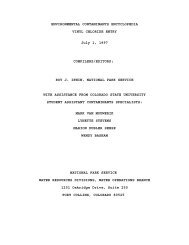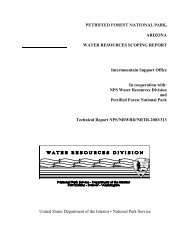ENVIRONMENTAL CONTAMINANTS ENCYCLOPEDIA ...
ENVIRONMENTAL CONTAMINANTS ENCYCLOPEDIA ...
ENVIRONMENTAL CONTAMINANTS ENCYCLOPEDIA ...
You also want an ePaper? Increase the reach of your titles
YUMPU automatically turns print PDFs into web optimized ePapers that Google loves.
methylnaphthalene, and phenanthrene are the most commonly found in<br />
diesel and are the individual compounds posing the highest<br />
calculable risk due to ingestion [497].<br />
Naphthalene, benzo(a)pyrene, fluorene, and phenanthrene are<br />
common PAH components of used motor oil [75].<br />
Naphthalene, one of the more important components derived from<br />
the second distillation fraction when distilling coal tar from<br />
coal, is employed in the production of dyes and synthetic resins<br />
[279]. It is also used for lubricants, explosives, fungicides, and<br />
moth repellents and as a solvent and preservative [279].<br />
Nearly all naphthalene entering the environment is released<br />
directly to the air (92.2%). The largest source of emission (more<br />
than 50%) is through inadvertent releases due to residential<br />
combustion of wood and fossil fuels [766].<br />
Naphthalene enters the atmosphere primarily from fugitive<br />
emissions and exhaust connected with its presence in fuel oil and<br />
gasoline. In addition, there are discharges on land and into water<br />
from spills during the storage, transport and disposal of fuel oil,<br />
coal tar, etc. [366].<br />
About 5% of all naphthalene entering the environment is<br />
released to water. Most of that amount is attributable to coal tar<br />
production and distillation processes. Some naphthalene (about 60%)<br />
from these sources is discharged directly to surface waters; the<br />
remainder is distributed to wastewater treatment plants. The only<br />
other contributions of any consequence enter the nation's waterways<br />
from wood preserving industry effluent and from oil spills [766].<br />
To study water soluble leachates from out-of service railway<br />
ties, one gram of wood was shaved from the surface of the railroad<br />
ties and agitated in water for 24 hours. Up to 88.9 ug/L of<br />
naphthene was found in the water [864].<br />
This compound is found in floor wax and many other products<br />
and may be a lab contaminant [971].<br />
Natural Sources [366]:<br />
Component of crude oil; since naphthalene is a natural<br />
combustion product, forest fires, etc may be a source of<br />
naphthalene. (SRC) .<br />
One common PAH, naphthalene, occurs naturally in the<br />
essential oils of the roots of Radix and Herba ononidis<br />
[Patty. Indus Hyg & Tox 3rd ed Vol2A, 2B, 2C, 1981-1982<br />
p.3333].<br />
Artificial Sources [366]:<br />
Emissions from its production from petroleum refining and<br />
coal tar distillation(1); Emissions and wastewater from<br />
its use as a chemical intermediate(2); Motor vehicle<br />
emissions; tobacco smoke(3); coal tar pitch fumes(1); Oil<br />
spills(SRC). [(1) Verschueren K; Handbook of<br />
Environmental Data on Organic Chemicals; 2nd ed Van<br />
Nostrand Reinhold Co New York NY p.892 (1983) (2) Kirk-<br />
Othmer Encyclopedia of Chemical Technology; 3rd ed 15:698

















